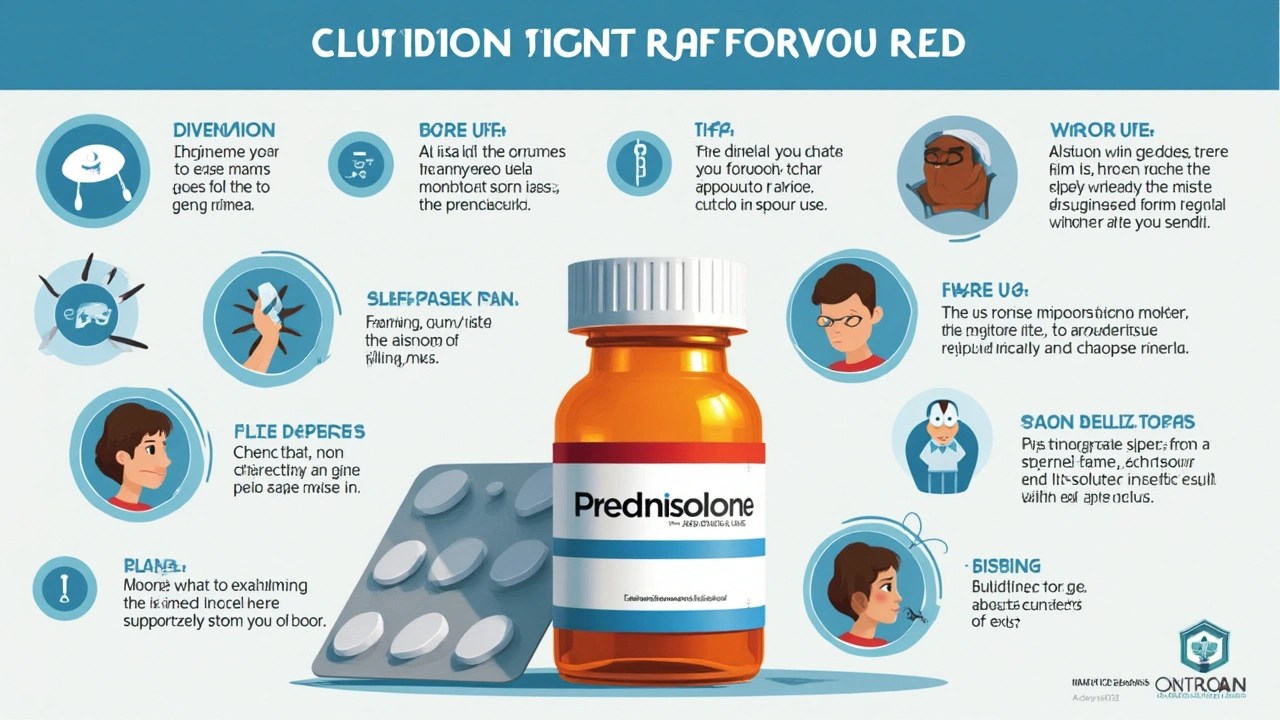Imagine getting smacked with a flare-up from your immune system, feeling like the inflammation is running your entire body. That's when prednisolone steps in – not as a miracle, but as a practical solution that rolls back the painful symptoms and brings life sort of back to normal. Doctors hand it out for everything from asthma attacks to arthritis and allergic rashes, but not without their share of warnings. What’s so special about this steroid? Is it just a quick fix, or is there more beneath the label? Let’s strip it down, bust some myths, and tackle what you really need to know before it ends up on your prescription list.
How Prednisolone Works and Who Needs It
Prednisolone gets its power from the steroid family, specifically as a glucocorticoid. It's like flipping the switch that tells your immune system, "hey, slow down!" When immune cells are working overtime (think asthma, lupus, or a brutal allergic reaction), this drug steps in and tells them to calm the heck down. It mimics the natural hormone cortisol that your body makes in your adrenal glands. In normal times, cortisol handles a bunch of critical jobs – fighting stress, keeping inflammation in check, and balancing your metabolism. But during illness or inflammation storms, your body's own system sometimes can't keep up. That’s the opening for prednisolone.
Doctors recommend it for a stack of issues: rheumatoid arthritis when your joints scream with pain; severe eczema when lotions don't cut it; chronic asthma that laughs at puffers; and autoimmune diseases where the body turns against itself. It’s also a front-line choice for nasty allergic reactions, severe ulcerative colitis, and some cancers like leukemia. What’s wild is that the World Health Organization pops prednisolone into its List of Essential Medicines, meaning you’re likely to run into it whether you’re in Melbourne or Morocco.
As a pill, liquid, or injection, prednisolone comes in different strengths. Standard adult dosages float anywhere from 5 mg to 60 mg daily, tweaked by your doctor depending on how intense things are. Kids get lower doses, based on their weight. Hospitals might use it for just a few days during a crisis (like a child barely wheezing through an asthma attack) or doctors might stretch out the dose for months if you’re facing something chronic – but long-term use always comes with a laundry list of things to watch out for. Worth knowing: in 2023, the Royal Melbourne Hospital pumped out a study showing prednisolone prescriptions spiked post-pandemic, with about 1 in 18 adult Australians filling a prednisolone script at some point during the year.
One interesting fact is that, in Australia, you can't just buy prednisolone at the chemist – it’s prescription only. Part of the reason is, taking it without medical supervision can be a total disaster. It’s not like antibiotics; skipping doses or stopping suddenly can throw your body into a tailspin. Your adrenal glands might have gone lazy while the drug did their work, so snapping off the meds cold turkey can leave you feeling worse than before.

Managing Side Effects and Staying Safe On Prednisolone
Now here’s where people get nervous. The benefits are legit, but the side effects get real, especially if you’re in it for the long haul. Half the horror stories you hear online come from folks who had no clue what to expect. Let’s get into what the research and doctors in our own city actually see day-to-day.
Common side effects? Think mood swings, trouble sleeping, rounder face (that “moon face” folks talk about), weight gain (because it makes you crave snacks like mad), and even acne. Your immune system is busy being told to pipe down, so you can pick up infections easier. The skin can turn thin, and healing slows way down. Anyone on it for a while should be on the lookout for weak bones or osteoporosis and high blood pressure. If anyone at my house (Elena included!) is ever on steroids, we’re on alert for frequent colds, downswings in mood, or sleep getting wrecked – these aren’t rare side effects, they’re actually pretty common.
What really worries specialists is long-term stuff. Diabetes, serious infections, eye conditions like glaucoma or cataracts, even muscle weakness. Kids might stop growing properly, which is why pediatricians keep a close eye. Here’s a stat from the Australian Bureau of Statistics: in a five-year track of long-term steroid users, nearly 40% ended up with bone density loss or issues with blood sugar. Below is a quick visual summary (these percentages reflect occurrences across Australian hospital records):
| Side Effect | Frequency (%) | Notes |
|---|---|---|
| Weight Gain | 47 | Usually within first 3 months |
| Mood Disorders | 18 | Anxiety, irritability, sometimes euphoria |
| Osteoporosis | 38 | Mainly with doses over 10 mg/day for >3 months |
| Infection | 21 | Common cold, shingles, or chest infection risk increases |
| Elevated Blood Sugar | 33 | Some progress to diabetes |
Want to keep side effects in check? Stick with what your doc says – don’t mess around with the dose and always take the medication in the morning if possible. That helps match your body’s natural cortisol cycle and reduces sleep troubles. If you’re on it for more than a few weeks, calcium and vitamin D (either via diet or supplements) becomes super important. Snack smart and watch salt—prednisolone can make your body hold onto fluids like a sponge. Staying active helps too, even if all you can manage is a brisk walk with your dog.
Here are some quick tips for avoiding the nastier side effects:
- Take prednisolone with food to save your stomach.
- Wear a medical alert bracelet if you’re on long-term or high-dose therapy – this tells emergency crews what’s up if you can’t speak for yourself.
- Keep up regular blood tests, especially for sugar and salt levels, if you’re on a decent dose.
- Let your dentist know about your medication, since healing slows down and gums can suffer.
- Never run out suddenly—always ask your GP how to taper off safely, otherwise you risk something called “adrenal crisis.”
- If you catch an infection or fever, tell your doctor right away. Your immune response might be turned down and things can get dicey fast.
Reading the patient info sheet helps, but real advice for Aussies? Get a second opinion if you’re ever unsure, especially if the script looks like it’ll last more than a few weeks. Don’t feel like you’ve got to handle side effects solo; chat with your GP, a pharmacist, or—if you’re like my mate who had a nasty prednisone stint—your local patient support group. Some pharmacies in Victoria even run dedicated clinics to help people manage their medicine plans.

Tips For Living Well With Prednisolone: Everyday Hacks and Myths
Taking prednisolone isn’t just about swallowing a pill and hoping for the best. There are some simple hacks that can make the ride smoother, and quite a few myths floating around that are worth busting.
First, your daily routines matter. Set a reminder on your phone so you don’t skip a dose. I had a neighbour who stuck post-its on her coffee maker just to keep on track. Mood swings or extra energy surges usually fade a bit after your body gets used to the drug. But if your sleep crashes, try taking your dose at breakfast, not dinner—melatonin and winding down early can help if all else fails. If you notice your face looking puffy or your waistline starts expanding, you can blame the hormone effect rather than your lunch choices. That said, swap chips and sweets for nuts, fruit, and veggies. It won’t fix all the issues, but it definitely helps stabilize weight and blood pressure.
Exercise isn’t off the table. Actually, staying active even on just a moderate level will cushion you against muscle weakness or fragile bones that sometimes crop up with steroids. Gentle pilates or a yoga session won’t mess up your joints, even if you’re feeling achy. Sunscreen is smart too—your skin thins out, and you don’t want to come out of the experience covered in sunspots. At our house, I remind Elena every spring because we both burn like toast in the Aussie sun, and with prednisolone, your odds of that just go up!
Water retention and salty foods—is it fact or fiction? Fact. High-salt snacks will puff you up like a blowfish, so watch your sodium. Trade in the takeaways for something you can make at home with less added salt; your ankles will thank you. Hydrate extra—plain water or herbal tea. You will notice a difference in how you feel each day.
Myths really do the rounds, and the most common one is that prednisolone is the same thing as anabolic steroids that athletes abuse. Totally different beast—prednisolone helps curb inflammation, not bulk you up. Another tale is that you can just stop whenever symptoms disappear. That’s a fast track to feeling way sicker because your adrenal system needs time to wake up after the assist. Or the one about having to accept major weight gain no matter what—some is normal, but you have more control than you think with diet tweaks and regular movement.
If you’re worried about mixing prednisolone with your other meds, ask your pharmacist for a quick “medication check”—they know which drugs can clash and mess up your liver, stomach, or immune response. If alcohol is part of your social life, you don’t have to give it up completely with short-term use, but extended or heavy drinking with high prednisolone doses can push your liver and raise your risk for ulcers.
One more hack that actually works? Keep a “side effect journal.” Log your mood, sleep, appetite, any weird bruises, new colds—whatever pops up. Not only does it help you see patterns, but your doctor will have a way easier time troubleshooting if you ever need adjustments to your plan. Prednisolone is effective and, for a lot of us, essential when health spirals out of control. With a few smart choices, a little backup from the experts, and honest tracking of what’s happening, you can keep life rolling even when you need a little outside help from modern medicine.
Every drug has its trade-offs, but knowledge and smart habits mean you campaign for yourself, not against your body. If you get handed a script for prednisolone, remember every blister pack and side effect is there for a reason and there are plenty of ways to make the road a bit less rocky.






Anoop Choradia
July 18, 2025 AT 16:38Upon meticulous examination of the detailed guide provided on prednisolone, one cannot help but appreciate the rigorous attempt to dissect the pharmacodynamics and therapeutic implications of this glucocorticoid steroid. However, it behooves us to critically evaluate the potential biases and omnipresent pharmaceutical propaganda that might subtly influence such narratives.
The usage guidelines, while seemingly comprehensive, should ideally be cross-examined with independent clinical trials and meta-analytic evidence to ascertain efficacy and safety across diverse patient demographics. The discussion on side effects, though present, might undersell the complexity of adrenal suppression and immunosuppressive risks that are well-documented yet frequently understated.
Furthermore, the dosage recommendations should underscore the necessity for individualized titration based on intricate factors such as patient metabolism, concomitant conditions, and genetic predispositions. A more granular approach, perhaps supplemented by pharmacogenomic testing, would elevate the clinical utility of the guide.
In summation, while the guide offers a foundational understanding for the layperson and practitioner alike, it must be approached with a critical lens and supplemented by robust, peer-reviewed evidence to truly harness the therapeutic potential of prednisolone without succumbing to oversimplified dogma.
bhavani pitta
July 21, 2025 AT 19:25Honestly, I find this guide a bit too polished, and I can't help but wonder if it glosses over some of the more harrowing experiences folks have on prednisolone. The side effects section feels a bit cookie-cutter, as if it’s trying not to scare off potential users.
Everyone reacts so differently to steroids, and the emotional rollercoaster isn’t just a footnote here — it's a full-blown ride that changes your life. I’m talking mood swings, insomnia, and anxiety that the guide mentioned almost nonchalantly. I firmly believe that more emphasis should be placed on these to prepare patients properly.
Also, the tips for safe steroid treatment are somewhat generic. Real-world scenarios include battles with weight gain, skin issues, and battles with self-esteem. I think any guide worth its salt wouldn’t shy away from these realities but embrace them head-on.
Brenda Taylor
July 25, 2025 AT 02:41Thanks for sharing this guide, but I feel like it barely scratches the surface tbh. Like, yes, it tells you about dosages and side effects, but where's the advice on how to actually deal with them day-to-day? Sometimes, people need more practical tips than just medical jargon.
Also, the tone is kind of dry and makes it all seem less serious than it really is. People don’t always want long articles full of facts without any real empathy or understanding for how tough steroid treatment can be.
I would have liked to see some stories or examples that show what real people go through, you know? That would make the whole thing more relatable and maybe less intimidating.
😊Taryn Thompson
July 28, 2025 AT 17:41This guide indeed offers a succinct yet comprehensive overview of prednisolone, which is commendable given the complexity of steroid treatments. For those unfamiliar, prednisolone is a synthetic corticosteroid widely used to treat inflammatory and autoimmune conditions.
It is crucial, however, to emphasize starting with the lowest effective dose and then tapering off to minimize the risk of adverse effects such as adrenal insufficiency. Taking steroids without medical supervision can lead to serious complications. So, patient education, like what's partially covered here, must be paired with regular medical follow-ups.
A noteworthy tip for safe steroid treatment is monitoring bone density and blood sugar levels during prolonged use, which I think the guide could have underscored more explicitly. Overall, it is an excellent starting point, and I encourage anyone prescribed prednisolone to consult their physician thoroughly and report any new or worsening symptoms.
Paul Hill II
August 1, 2025 AT 02:28I appreciate the effort to distill complex medication info into an accessible guide. From a linguistic standpoint, the explanations are clear though sometimes might benefit from simpler terminology for a broader audience.
One thing that struck me was the balance it tries to strike between data-driven insights and anecdotal experiences. While real-life scenarios are mentioned, I feel more of them peppered throughout could enhance the narrative flow and user connection.
Also, it might be useful to include a small FAQ for common concerns like interactions with other meds or lifestyle modifications while on prednisolone. Such additions can empower patients to manage their treatment proactively and with confidence.
Thoughts on this approach, anyone?
Stephanie Colony
August 4, 2025 AT 12:30Honestly, if you seriously think prednisolone is everything it’s cracked up to be, I have to disagree. Yes, it works, but people conveniently skip over the fact that long-term steroid use can wreck your body in so many ugly ways.
The guide’s soft-pedaling of side effects is typical — mostly only mentioning the common ones and downplaying things like chronic fatigue, osteoporosis, and the damaging psychological effects that can leave patients mentally scarred.
Medical elitism at its finest, making it look all clinical and neat, while the reality is messier and harsher. I’d like to see more brutal honesty, because we owe patients the truth, not just a PR-friendly pamphlet.
Abigail Lynch
August 7, 2025 AT 19:51Yawn, another typical medical write-up that seems suspiciously sanitized. Are we sure the “expert advice” here isn’t just parroting industry talking points? How much is really disclosed about the long-term consequences and dependency risks?
I mean, take a closer look at the 'safe steroid treatment' tips—they’re vague enough to let a lot slide under the radar. How convenient! I wouldn’t trust any guide that doesn’t explicitly warn about the inevitable withdrawal hell many experience.
And yeah, while the guide is all 'information,' it barely touches on the emotional and psychological wreckage prednisolone wreaks on users. Makes you wonder who’s really writing this stuff, huh?
David McClone
August 11, 2025 AT 04:53Wow, this guide is quite the colorful piece in terms of information delivery! I’m curious though, isn't the immunosuppressive nature of prednisolone the real double-edged sword here? It calms inflammation but opens the door for infections. How well do you think this risk is managed in clinical practice?
Also, the personalization of dosage mentioned sounds great on paper, but given the variability in patient responses, do you think current protocols adequately capture this individual nuance?
Overall, good read but makes me wonder about the gaps between recommended use and real-world application.
Jessica Romero
August 14, 2025 AT 15:53This guide to prednisolone is comprehensive yet it touches briefly on many complex pharmacological and physiological concepts that deserve more depth. For instance, the mechanisms by which prednisolone suppresses inflammation involve not just corticosteroid receptor binding but also genomic and non-genomic pathways affecting multiple organ systems.
Furthermore, the tips for side effect management could delve deeper into diet optimization, bone health strategies, and psychological support during therapy. Long-term steroid use requires multidisciplinary care, involving endocrinologists, dieticians, and mental health professionals.
In terms of dosage, giving more specifics about tapering schedules and the rationale behind dose adjustments would greatly enhance patient understanding and adherence. This guide is a solid foundation but could be more robust with integrated clinical practice guidelines and case studies.
Michele Radford
August 17, 2025 AT 08:53The guide seems extremely sanitized and sanitized guides often reflect the sanitized realities pharmaceutical companies prefer. It’s almost laughable how little attention is given to the darker sides of steroid treatment. One could argue that anything that suppresses the body’s natural immune responses to the extent that prednisolone does is a ticking time bomb.
Side effects like psychosis, opportunistic infections, and metabolic havoc don't deserve to be mere footnotes; they are potential life-ruining events.
Patients deserve transparency, not superficial gloss. Considering the prevalence of steroid misuse, especially in certain communities, guides like this unintentionally contribute to reckless self-medication.
Mangal DUTT Sharma
August 17, 2025 AT 16:38Reading through this guide, I can relate firsthand to the rollercoaster ride prednisolone can be. It’s not just about dosage or side effects; it’s an emotional and physical battle every day. From my experience, mapping out a clear timeline of expected changes and symptoms helps tremendously.
One tip I’d add is keeping a symptom diary — noting energy levels, mood changes, and appetite fluctuations. It empowers communication with doctors and can aid in fine-tuning the treatment plan.
Also, don’t underestimate the power of community support. Talking to others on steroids reminded me I wasn’t alone and gave practical coping tips you won’t find in any guide.
Despite all the turmoil, with care and attention, the benefits can outweigh the hardships, but only if patients are truly informed and supported throughout.
😊